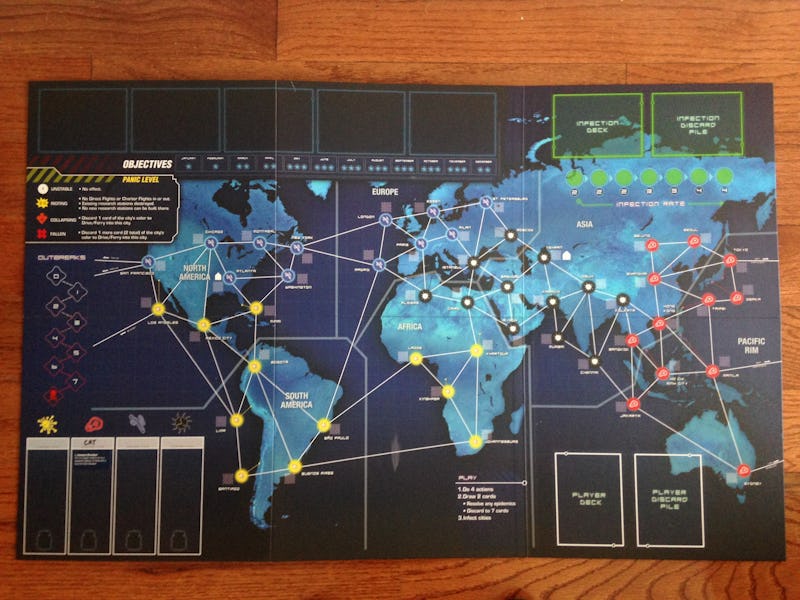The Year of Living Epidemically: Our Journey Through Pandemic: Legacy
Can we keep the world safe from plastic germs?

Pandemic: Legacy, a co-op game in which players battle cubes of infection, is typical in the sense that it features cards, plastic pawns and chits, and a cardboard map of the world. But it is an outlier — like Risk Legacy before it — because there are no clean slates. Your decisions while playing alter the way the game is played, in permanent and unforeseen ways. If there is a guiding ethos to Pandemic: Legacy, it’s that life doesn’t have take-backsies.
Over the next few weeks, we’ll use this space to wade through the in-game year of trials Pandemic spews our way, updating this post with our triumphs and follies as the campaign progresses. It feels a bit strange to write this much about a board game, but, in the spirit of free discussion, there will be spoilers as we pop open some of Pandemic’s secrets.
Game 1, January: The Fellowship of the Ringworm Assembles
Ben: I jumped into Pandemic: Legacy and was immediately uncomfortable. I’m fine with fictional disease, and our first January mission was just that of regular, vanilla Pandemic: Cure all four colors of disease by building a hand of the right five cards, without letting the world get overrun. But the concept of scribbling on a game piece runs counter to my preservationist instincts. Until this point, writing on a game was, if not defacement, at least weird.
Once I got over that hump, though, I embraced the birth of ‘Dwayne the Rok J’ (what I could fit with my childlike Sharpie scrawl) with all the joy a new dad can muster. Dwayne, as a medic, did pretty solid work; because he could hoover up disease cubes simply by encountering them once we’d found the cure, he single-handedly cleared large swaths of black disease cubes from Eurasia. To be honest, though, Zoltan the Dispatcher was our MVP, rocketing our pawns across the board when we needed to team up to trade cards, with Lana’s superior science a close second.
Yas: Lana “The Scientist” Del Rey’s ability to cure disease with just four cards came in handy when curing — and eradicating forever! — the dreaded red protozoa Toxoplasma gondii (aka “CAT” disease, forevermore in Sharpie). This round was a lot less stressful than our first game because there weren’t nearly as many outbreaks to deal with. That’s probably because we figured out it was more efficient to treat cities to manageable levels, rather than waste actions by curing them altogether. Looking forward to starting the next round with a CDC station on the other side of the globe. Can’t wait till the riots and fires start!
Neel: Zoltan for MVP? You’re too kind, Dwayne. I think we simply managed to stumble on some abilities we didn’t take advantage of the last time we played. I mean, the Dispatcher’s power to just teleport someone to another city? Technology these days really needs to catch up to what our board game avatars are capable of. Along the lines of what Yasmin is saying, we definitely went in the correct direction of trying to manage and contain diseases at first, rather than a full on eradication on the onset. From what I know, that’s actually how most municipalities are supposed to deal with disease epidemics anyways.
Ben: We should pat ourselves on the back for surviving January, but we’re only one month into the campaign. I’ve got a bit of crush on the upgrade aspect — the legacy appeal becomes immediately apparent in the post-game stage. Altering a game rule forever is so unlike any other game I’ve played, though it comes at the cost of never going back. It’s like playing a videogame with a single save file you can never overwrite. At the end of January, for instance, because we eradicated CAT, we were able to name it and then slap a sticker down on the board, giving the disease a “positive mutation”: The next time it spreads over the globe, CAT will be easier to combat, as we won’t have to schlep over to a country with a research station. Plus, Tehran joins Atlanta in having a permanent — at least for now — center for cube control.
That being said, I’m terrified of what’s going to bubble up in February. I felt like we won this game pretty handily, until I took a look at our stack of player cards and realized we were two turns away from running dry and losing the whole thing. Next time, plagues.